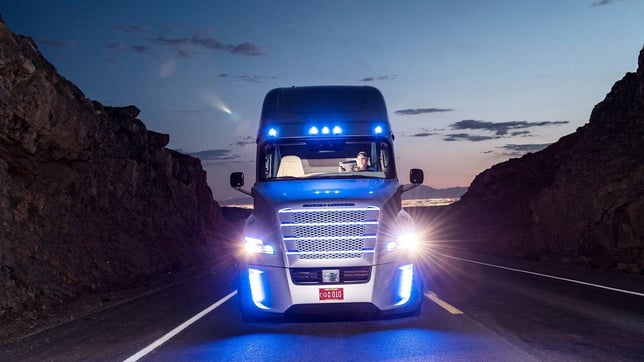REDWOOD LOGIN
Redwood PortalLTL
SCS
SCS Support
Rockfarm
Technology is advancing to the point where companies like Google, Uber, and Tesla are investing large chunks of their resources to develop self-driving trucks. The end goal is automated shipping, where a driverless truck can pick up and deliver a shipment without issues. But what does that mean for today’s truck drivers?
There are roughly 3.5 million truck drivers in the United States right now and driverless trucks are a direct threat to those drivers. These jobs are not going to evaporate overnight, but there will definitely be a trickle effect as driverless trucks and autonomous shipping become a reality in the near future.
In this article, we’ll take a look at how self-driving trucks will affect the immediate and distant future of America’s truck drivers.
 Even with the threat of self-driving trucks looming, drivers have little to fear in the immediate future. With online shopping becoming more of a routine part of consumers’ lives, shipping needs continue to grow. There is currently a shortage of drivers across the country. According to the American Trucking Associations (ATA), there is a shortage of about 51,000 truck driving jobs across the country. Trucks today carry about 70 percent of all goods shipped in the US that totals roughly 10.7 billion tons this year, which lead to $719 billion in industry revenue. Due to a growing economy, the ATA expects the logistics industry to grow by 3.4 percent annually until 2023.
Even with the threat of self-driving trucks looming, drivers have little to fear in the immediate future. With online shopping becoming more of a routine part of consumers’ lives, shipping needs continue to grow. There is currently a shortage of drivers across the country. According to the American Trucking Associations (ATA), there is a shortage of about 51,000 truck driving jobs across the country. Trucks today carry about 70 percent of all goods shipped in the US that totals roughly 10.7 billion tons this year, which lead to $719 billion in industry revenue. Due to a growing economy, the ATA expects the logistics industry to grow by 3.4 percent annually until 2023.
As self-driving trucks are still in the development stage, the increased shipping demand and low availability has become the perfect storm for logistics companies. After the implementation of electronic log devices (ELDs) at the end of 2017, shipping costs rocketed skyward since no one – including the freight carriers – were quite sure how the transition would go. Now that shippers and logistics companies have adapted to the ELDs, the rates have flattened out a bit but they are still higher, which is an obvious benefit for the logistics companies.
While companies like Google, Uber, and Tesla try to perfect their driverless trucking technology, logistics companies are reaping the benefits. The was driverless technology is developing though, this could be the swan song for America’s truck drivers. The future for truck drivers looks good in the short term, but there is little optimism in the long-term outlook.
 There is one thing on the side of companies investing in self-driving technology – time. Most experts agree that over time, driverless trucks will revolutionize the shipping market in a way that will benefit shippers but likely eliminate most of the 3.5 million truck driver jobs in America. The technology will not develop overnight, so the number of truck driver jobs will slowly diminish over time. The first self-driving that are put into everyday use will not necessarily be driverless either.
There is one thing on the side of companies investing in self-driving technology – time. Most experts agree that over time, driverless trucks will revolutionize the shipping market in a way that will benefit shippers but likely eliminate most of the 3.5 million truck driver jobs in America. The technology will not develop overnight, so the number of truck driver jobs will slowly diminish over time. The first self-driving that are put into everyday use will not necessarily be driverless either.
The first wave of these self-driving trucks will require a driver to be in the cab of the truck, though not driving. The driver will be there to take over if there is a failure in the technology or for any other reason. Some start-ups envision a fleet of driver-less trucks lead by a few trucks with human drivers. Peloton Technology is a startup that is trying to come up with automated trucks that can communicate with each other and follow a lead truck with a human driver. There can be a driver in each truck, but they won’t need to have their feet on the pedals or hands on the wheel. They can be catching up on their rest, filling out paperwork or using a laptop.
Highway driving is not much of a hurdle when developing self-driving trucks. When trucks get into metropolitan areas with more traffic and tighter streets, this is where self-driving technology faces a bit of adversity. A startup called Starsky Robotics has a solution for this type of driving and it does include a driver, but not in a traditional sense. “Drivers” would be at a central location behind a desk with the ability to control the truck from a remote location. So instead of having a driver behind the wheel, the truck could be controlled like something straight out of a video game.
While there are some companies developing self-driving technology that would have a need for drivers in some aspect, the number of drivers needed would go down drastically. Goldman Sachs has predicted that the driving industries could lose upwards of 300,000 jobs per year as driving automation grows. Every day, companies like Uber, Tesla, and Google get a little bit closer to their goal of self-driving trucks, which means that America’s truckers are one day closer to being replaced by technology.